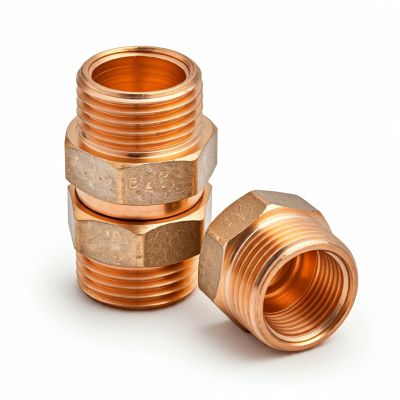Compression fittings are a versatile and reliable method for connecting copper pipes. This guide will provide a comprehensive overview, covering everything from the basics of compression fittings to installation techniques and maintenance tips.
Whether you’re a DIY enthusiast or a professional plumber, this resource will help you understand and utilize copper-to-copper compression fittings effectively.
What Are Copper-to-Copper Compression Fittings?
Compression fittings are a type of mechanical connector used to join copper pipes together. Unlike soldered or brazed connections, compression fittings create a seal by compressing a ferrule against the pipe and fitting body. This method offers several advantages, including leak-proof connections, reusability, and ease of installation.
Components of a Compression Fitting
A typical compression fitting consists of three main parts:
➡️ Nut: A threaded nut that secures the ferrule onto the fitting body.
➡️ Ferrule: A metal ring that creates the seal between the pipe and fitting body.
➡️ Body: The main part of the fitting, which houses the pipe and ferrule.
How Compression Fittings Work for Copper Pipes
When a compression fitting is assembled, the nut is tightened, causing the ferrule to expand and create a tight seal against both the pipe and the fitting body. This compression force prevents leaks and ensures a secure connection.
Advantages of Using Copper-to-Copper Compression Fittings
➡️ Leak-proof Connections: Compression fittings provide reliable and leak-free connections, eliminating the risk of water damage or gas leaks.
➡️ Reusability and Ease of Disassembly: Unlike soldered or brazed connections, compression fittings can be easily disassembled and reused, making them ideal for temporary installations or projects where modifications may be necessary.
➡️ Durability and Reliability: Compression fittings are designed to withstand high pressure and temperature, making them suitable for a wide range of applications, including plumbing, heating, and gas lines.
➡️ Common Applications: Copper-to-copper compression fittings are commonly used in various settings, such as:
-
➡️ Residential plumbing systems
-
➡️ Commercial and industrial applications
-
➡️ HVAC systems
-
➡️ Gas lines
Types of Copper-to-Copper Compression Fittings
Compression fittings come in various shapes and sizes to accommodate different pipe configurations and applications. Some common types include:
➡️ Standard Compression Fittings: These are basic fittings used to connect two straight lengths of copper pipe.
➡️ Compression Elbows, Tees, and Couplings: These fittings allow for changes in direction, branching, and coupling of pipes.
➡️ Specialty Compression Fittings: For specific applications like gas lines or HVAC systems, there are specialized fittings designed to meet industry standards and requirements.
Choosing the right type of compression fitting depends on the specific needs of your project, such as pipe size, application, and desired connection configuration.
How to Install Copper-to-Copper Compression Fittings
Installing copper-to-copper compression fittings is a relatively straightforward process that can be completed with basic tools. Here’s a step-by-step guide:
1. Gather Tools: You’ll need a pipe cutter, adjustable wrenches, and a tape measure.
2. Cut the Copper Pipe: Measure and cut the pipe to the desired length using a pipe cutter.
3. Insert the Pipe: Slide the pipe into the fitting body.
4. Tighten the Compression Nut: Using an adjustable wrench, tighten the compression nut until it’s snug but not overly tight.
5. Check for Leaks: After tightening the nut, check for any leaks by turning on the water or gas supply. If there are no leaks, the fitting is properly installed.
Common Mistakes to Avoid:
➡️ Overtightening: Excessively tightening the compression nut can damage the ferrule or pipe.
➡️ Cross-Threading: Ensure that the threads on the nut and fitting body are aligned correctly to prevent cross-threading.
➡️ Using Incorrect Fittings: Always select the appropriate fitting type based on the pipe size and application.
Maintenance and Troubleshooting Copper-to-Copper Compression Fittings
Proper maintenance is essential for ensuring the long-term performance of compression fittings. Here are some tips:
➡️ Inspect Regularly: Periodically check the fittings for any signs of wear, corrosion, or leaks.
➡️ Tighten as Needed: If you notice a slight leak, gently tighten the compression nut to secure the connection.
➡️ Replace Faulty Fittings: If a fitting is damaged or leaking excessively, it should be replaced to prevent further problems.
Signs of a Faulty or Leaking Fitting:
➡️ Water or gas leaks around the fitting
➡️ Unusual noises or vibrations
➡️ Difficulty in tightening the compression nut
When to Consider Upgrading or Replacing Compression Fittings:
➡️ If the fittings are old or showing signs of wear and tear
➡️ If you intend to undertake a significant remodeling or renovation project
➡️ If you need to upgrade to a higher-pressure or temperature rating
Conclusion
Copper-to-copper compression fittings offer a reliable and convenient solution for connecting copper pipes in various applications. Their leak-proof performance, reusability, and ease of installation make them a popular choice among homeowners, contractors, and professionals.
By following the guidelines outlined in this guide, you can ensure proper installation, maintenance, and troubleshooting of compression fittings to maintain a safe and efficient plumbing or gas system.
Post time: Sep-13-2024


